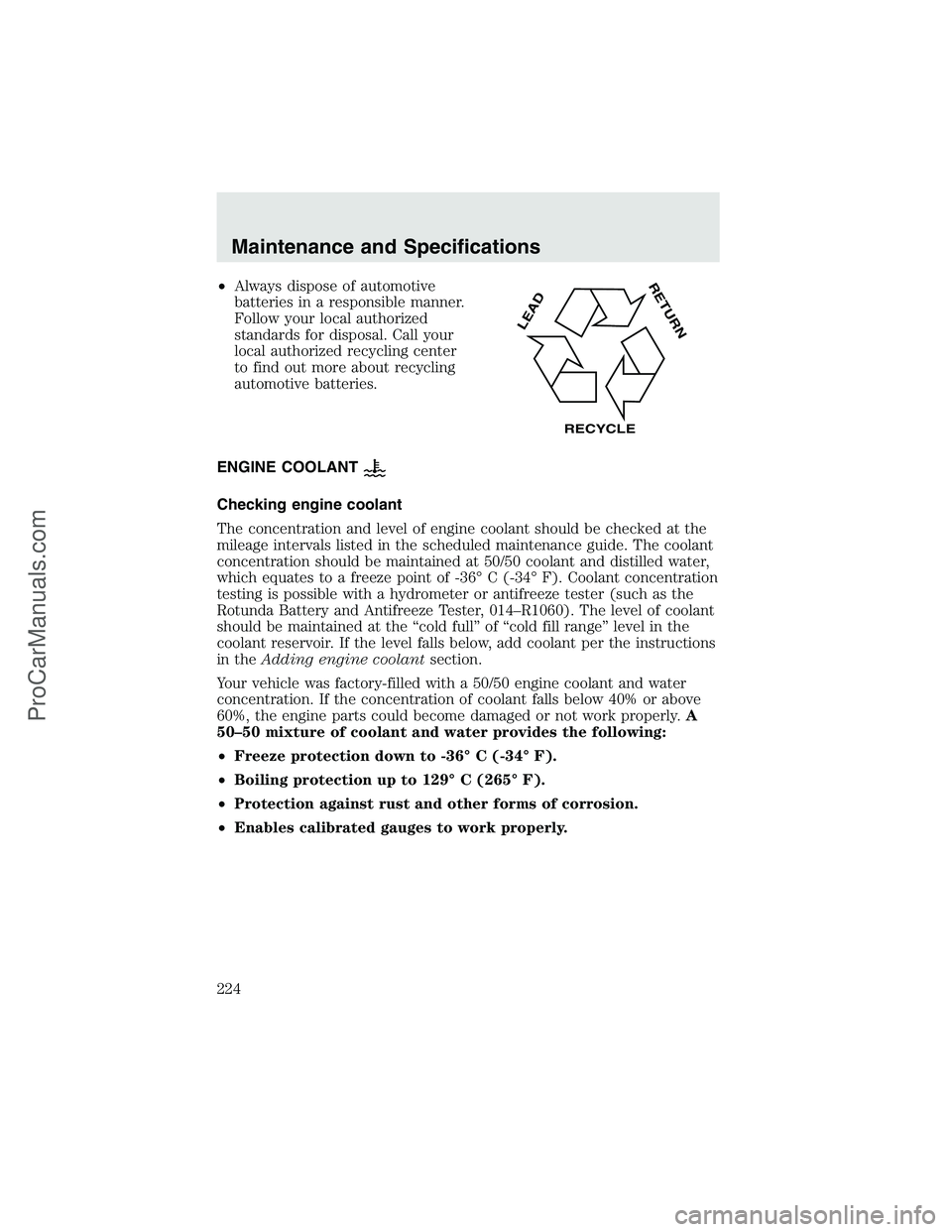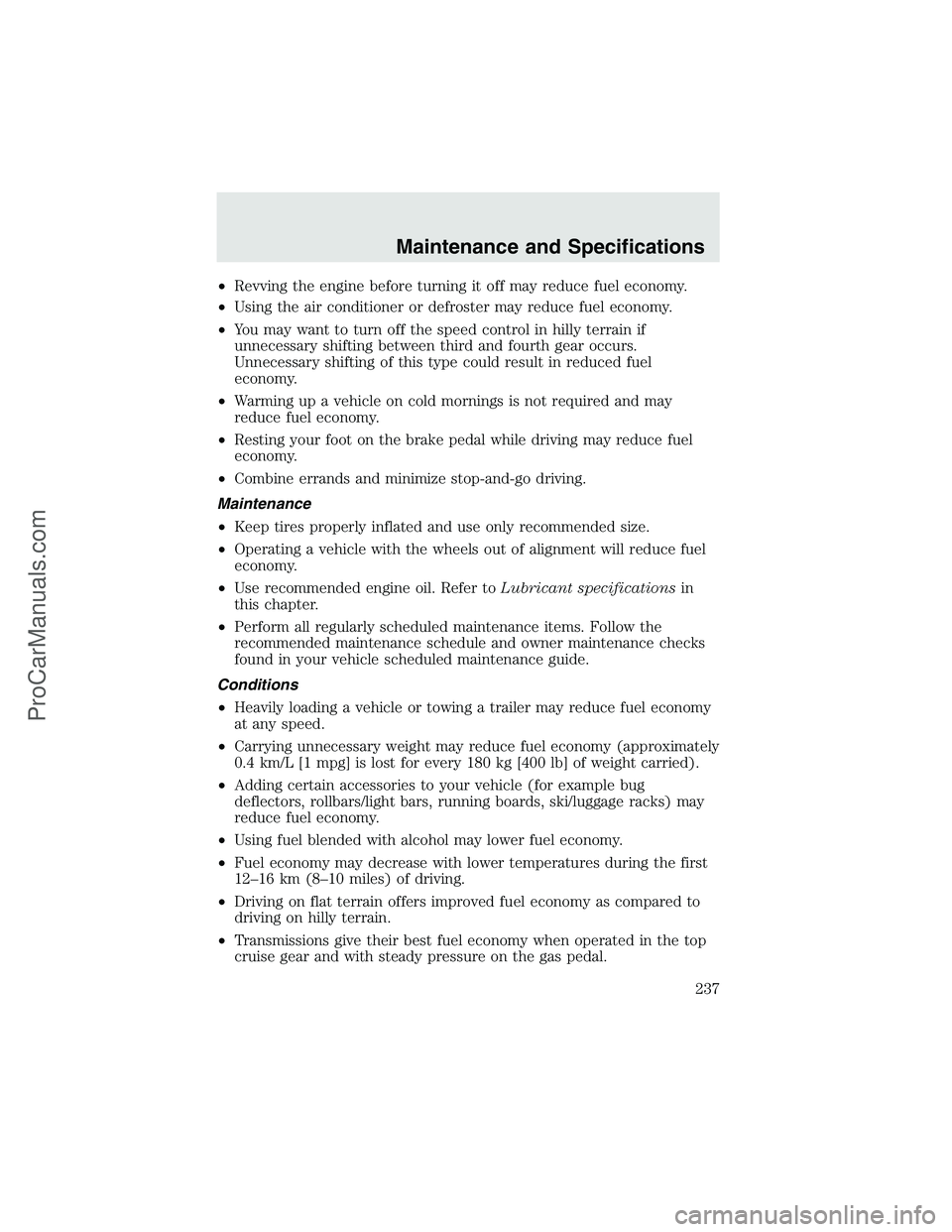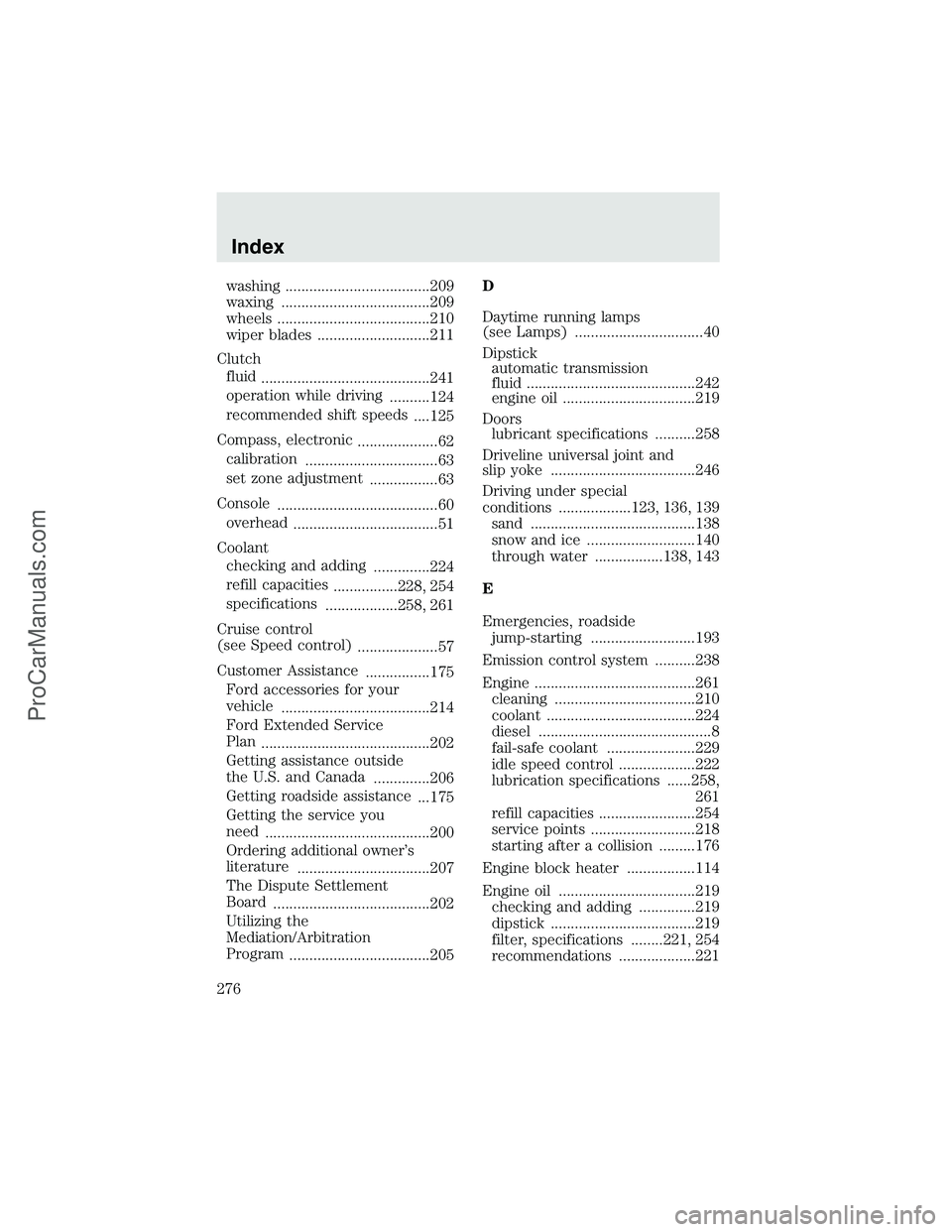2003 FORD F350 adding oil
[x] Cancel search: adding oilPage 220 of 280

5. Locate and carefully remove the
engine oil level indicator (dipstick).
6. Wipe the indicator clean. Insert the indicator fully, then remove it
again.
•If the oil level isbetween the MIN and MAX marks,the oil level is
acceptable.DO NOT ADD OIL.
•If the oil level is below the MIN
mark, add enough oil to raise the
level within the MIN-MAX range.
•Oil levels above the MAX mark may cause engine damage. Some oil
must be removed from the engine by a service technician.
7. Put the indicator back in and ensure it is fully seated.
Adding engine oil
1. Check the engine oil. For instructions, refer toChecking the engine
oilin this chapter.
2. If the engine oil level is not within the normal range, add only certified
engine oil of the recommended viscosity. Remove the engine oil filler cap
and use a funnel to pour the engine oil into the opening.
Maintenance and Specifications
220
ProCarManuals.com
Page 224 of 280

•Always dispose of automotive
batteries in a responsible manner.
Follow your local authorized
standards for disposal. Call your
local authorized recycling center
to find out more about recycling
automotive batteries.
ENGINE COOLANT
Checking engine coolant
The concentration and level of engine coolant should be checked at the
mileage intervals listed in the scheduled maintenance guide. The coolant
concentration should be maintained at 50/50 coolant and distilled water,
which equates to a freeze point of -36°C (-34°F). Coolant concentration
testing is possible with a hydrometer or antifreeze tester (such as the
Rotunda Battery and Antifreeze Tester, 014–R1060). The level of coolant
should be maintained at the“cold full”of“cold fill range”level in the
coolant reservoir. If the level falls below, add coolant per the instructions
in theAdding engine coolantsection.
Your vehicle was factory-filled with a 50/50 engine coolant and water
concentration. If the concentration of coolant falls below 40% or above
60%, the engine parts could become damaged or not work properly.A
50–50 mixture of coolant and water provides the following:
•Freeze protection down to -36°C (-34°F).
•Boiling protection up to 129°C (265°F).
•Protection against rust and other forms of corrosion.
•Enables calibrated gauges to work properly.
LEAD
RETURN
RECYCLE
Maintenance and Specifications
224
ProCarManuals.com
Page 237 of 280

•Revving the engine before turning it off may reduce fuel economy.
•Using the air conditioner or defroster may reduce fuel economy.
•You may want to turn off the speed control in hilly terrain if
unnecessary shifting between third and fourth gear occurs.
Unnecessary shifting of this type could result in reduced fuel
economy.
•Warming up a vehicle on cold mornings is not required and may
reduce fuel economy.
•Resting your foot on the brake pedal while driving may reduce fuel
economy.
•Combine errands and minimize stop-and-go driving.
Maintenance
•Keep tires properly inflated and use only recommended size.
•Operating a vehicle with the wheels out of alignment will reduce fuel
economy.
•Use recommended engine oil. Refer toLubricant specificationsin
this chapter.
•Perform all regularly scheduled maintenance items. Follow the
recommended maintenance schedule and owner maintenance checks
found in your vehicle scheduled maintenance guide.
Conditions
•Heavily loading a vehicle or towing a trailer may reduce fuel economy
at any speed.
•Carrying unnecessary weight may reduce fuel economy (approximately
0.4 km/L [1 mpg] is lost for every 180 kg [400 lb] of weight carried).
•Adding certain accessories to your vehicle (for example bug
deflectors, rollbars/light bars, running boards, ski/luggage racks) may
reduce fuel economy.
•Using fuel blended with alcohol may lower fuel economy.
•Fuel economy may decrease with lower temperatures during the first
12–16 km (8–10 miles) of driving.
•Driving on flat terrain offers improved fuel economy as compared to
driving on hilly terrain.
•Transmissions give their best fuel economy when operated in the top
cruise gear and with steady pressure on the gas pedal.
Maintenance and Specifications
237
ProCarManuals.com
Page 273 of 280

Door edge guards
Fender flares
Flat splash guards
Front end covers (full)
Hood deflectors
Leather wrap steering wheel
Locking gas cap
Lubricants and oils
Molded splash guards
Rear window deflector
Side window air deflectors
Stainless steel grill insert
Tailgate covers (Diamond plate)
Tonneau cover (soft)
Tonneau cover (hard, color keyed–Leer supplier branded)
Touch-up paint
Truck cover (full vehicle)
Universal floor mats
Wheels
Wheel covers
Wood trim - interim applique
For maximum vehicle performance, keep the following information in
mind when adding accessories or equipment to your vehicle:
•When adding accessories, equipment, passengers and luggage to your
vehicle, do not exceed the total weight capacity of the vehicle or of
the front or rear axle (GVWR or GAWR as indicated on the Safety
compliance certification label). Consult your dealer for specific weight
information.
•The Federal Communications Commission (FCC) and Canadian Radio
Telecommunications Commission (CRTC) regulate the use of mobile
communications systems - such as two-way radios, telephones and
theft alarms - that are equipped with radio transmitters. Any such
equipment installed in your vehicle should comply with FCC or CRTC
regulations and should be installed only by a qualified service
technician.
Accessories
273
ProCarManuals.com
Page 276 of 280

washing ....................................209
waxing .....................................209
wheels ......................................210
wiper blades ............................211
Clutch
fluid
..........................................241
operation while driving
..........124
recommended shift speeds
....125
Compass, electronic
....................62
calibration
.................................63
set zone adjustment
.................63
Console
........................................60
overhead
....................................51
Coolant
checking and adding
..............224
refill capacities
................228, 254
specifications
..................258, 261
Cruise control
(see Speed control)
....................57
Customer Assistance
................175
Ford accessories for your
vehicle
.....................................214
Ford Extended Service
Plan
..........................................202
Getting assistance outside
the U.S. and Canada
..............206
Getting roadside assistance
...175
Getting the service you
need
.........................................200
Ordering additional owner’s
literature
.................................207
The Dispute Settlement
Board
.......................................202
Utilizing the
Mediation/Arbitration
Program
...................................205D
Daytime running lamps
(see Lamps) ................................40
Dipstick
automatic transmission
fluid ..........................................242
engine oil .................................219
Doors
lubricant specifications ..........258
Driveline universal joint and
slip yoke ....................................246
Driving under special
conditions ..................123, 136, 139
sand .........................................138
snow and ice ...........................140
through water .................138, 143
E
Emergencies, roadside
jump-starting ..........................193
Emission control system ..........238
Engine ........................................261
cleaning ...................................210
coolant .....................................224
diesel ...........................................8
fail-safe coolant ......................229
idle speed control ...................222
lubrication specifications ......258,
261
refill capacities ........................254
service points ..........................218
starting after a collision .........176
Engine block heater .................114
Engine oil ..................................219
checking and adding ..............219
dipstick ....................................219
filter, specifications ........221, 254
recommendations ...................221
Index
276
ProCarManuals.com